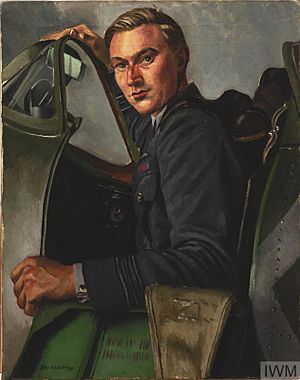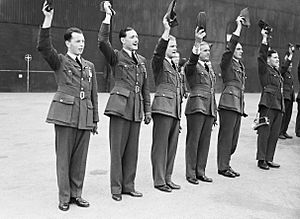James Leathart facts for kids
Quick facts for kids
James Leathart
|
|
|---|---|

Portrait of James Leathart, sitting in the cockpit of a Supermarine Spitfire fighter, painted by John Mansbridge in 1940
|
|
| Nickname(s) | 'Prof' |
| Born | 5 January 1915 London, United Kingdom |
| Died | 18 November 1998 (aged 83) |
| Allegiance | United Kingdom |
| Service/ |
Royal Air Force |
| Years of service | 1937–1962 |
| Rank | Air Commodore |
| Commands held | North Coates station Air Defence Operations Centre No. 148 Wing No. 89 Squadron No. 54 Squadron |
| Battles/wars | Second World War |
| Awards | Companion of the Order of the Bath Distinguished Service Order Mention in Despatches (2) |
James Leathart (5 January 1915 – 18 November 1998) was a brave British flying ace. He served with the Royal Air Force (RAF) during the Second World War. A flying ace is a pilot who has shot down at least five enemy aircraft. James Leathart was credited with shooting down eight enemy planes.
Born in London, Leathart joined the RAF in 1937. He had already been part of the Auxiliary Air Force before that. After his training, he joined No. 54 Squadron. He flew Supermarine Spitfire fighters during the Battle of France. During one mission, he used a training plane to rescue a downed RAF pilot from Calais, France. For this brave act, he received the Distinguished Service Order.
Leathart led No. 54 Squadron during the important Battle of Britain. He achieved more victories in the air during this time. Later in the war, he served in the Middle East. He also took part in the D-Day landings in Normandy on 6 June 1944. After the war, he stayed in the RAF. He held many important roles until he retired in 1962. He spent the rest of his life in Gloucestershire.
Contents
Early Life and Joining the RAF
James Anthony Leathart was born in London, UK, on 5 January 1915. He went to school in Oxford at St Edward's School. Later, he studied at the University of Liverpool. He earned a degree in electrical engineering.
In May 1936, while still a student, he joined the Auxiliary Air Force. This was a volunteer air force. He was one of the first members of No. 610 Squadron. This squadron was based at Hooton Park and flew Hawker Hart light bombers.
In May 1937, Leathart officially joined the RAF as a pilot officer. Because of his university education, his friends nicknamed him 'Prof'. He learned to fly at No. 3 Flying Training School. In November, he joined No. 54 Squadron. This squadron was based at Hornchurch and flew Gloster Gladiator fighters. In 1939, his squadron started flying the new Supermarine Spitfire fighter.
World War II Service
When the Second World War began, Leathart was a flight commander in No. 54 Squadron. His squadron flew its first mission on 6 September 1939. They saw little action at first. Their first success was on 13 February 1940. Pilots from Leathart's flight destroyed a Heinkel He 111 bomber over the English Channel.
Battle of France and a Daring Rescue
In May 1940, No. 54 Squadron flew over northern France. They protected British soldiers retreating from the German invasion. On 21 May, Leathart destroyed a He 111 near Dunkirk. The next day, he saw a Spitfire crash at an airfield in Calais. He realized it was the plane of Squadron Leader Francis White, a friend.
Leathart decided to try and rescue White. He flew a Miles Master, a two-seater trainer aircraft, back to Calais. Two Spitfires, including one flown by future ace Alan Deere, protected him. Leathart landed where White's plane crashed but couldn't find him. As he took off, several German Messerschmitt Bf 109 fighters appeared. Leathart landed again and ran for cover. To his surprise, White was hiding in the same ditch! Once it was safe, both men got into the Master. Leathart flew them safely back to Hornchurch.
No. 54 Squadron flew many missions during the evacuation of soldiers from Dunkirk. On 24 May, Leathart shot down a Bf 109. The next day, he destroyed a Messerschmitt Bf 110 heavy fighter. On 26 May, he shot down two more Bf 110s and a Junkers Ju 88 bomber. The next day, he shared in destroying another Ju 88. He was promoted to acting squadron leader and took command of his unit.
Fighting in the Battle of Britain
After intense fighting, No. 54 Squadron moved north for a rest. A few days later, James Leathart was awarded the Distinguished Service Order (DSO) for his bravery. The award mentioned his rescue of Francis White. It said he showed "great courage, determination and splendid leadership."
On 17 June, Leathart's squadron attacked German bombers. He claimed two Ju 88s destroyed. On 27 June, King George VI personally presented him with his DSO at Hornchurch.
During the Battle of Britain, Leathart continued to fight. On 20 July, he damaged a Dornier Do 17 bomber. On 18 August, he probably destroyed a Bf 109 over Kent. He also damaged another Bf 109 that day. On 28 August, he shot down a Do 17 near Manston. On 2 September, he destroyed a Bf 109 near Chatham. The next day, he probably destroyed another Bf 109. This was No. 54 Squadron's last day of fighting in the southeast of England. They moved north for a rest.
In October 1940, Leathart moved to a new role. He worked on aerial tactics for the Air Ministry. In March 1941, he joined Fighter Command. He helped with night fighter squadrons. Two months later, he helped set up a new night fighter unit for the Royal Canadian Air Force. This was No. 406 Squadron, which flew Bristol Beaufighter heavy fighters.
Later War Service and D-Day
In November 1941, Leathart was promoted to acting wing commander. He went to the Middle East to work at the RAF headquarters. In December, his squadron leader rank became permanent. After almost a year, he returned to flying. He became commander of No. 89 Squadron. This squadron flew Beaufighters and stopped German and Italian planes raiding the Nile Delta. On 22 February 1943, he destroyed a CANT Z.1007 bomber north of Tripoli.
Leathart's time flying missions ended in July 1943. He returned to the United Kingdom. He worked at the headquarters of No. 84 Group. He was mentioned in official reports for a second time in September. At the end of 1943, he became a pilot for Air Chief Marshal Trafford Leigh-Mallory. After the invasion of Normandy began on D-Day, he landed on one of the beaches. He had a radar set to help coordinate night fighter operations. Later, he became deputy senior air staff officer (SASO) at No. 85 Group. In March 1945, Leathart was promoted to acting group captain. He took command of No. 148 Wing, which flew de Havilland Mosquito night fighters.
After the War
After the war ended in Europe, Leathart attended the RAF Staff College. In September 1945, he was given a permanent role in the RAF as a squadron leader. In 1948, he worked at the headquarters of No. 66 Group. Two years later, he worked for the Joint Intelligence Bureau. In July 1955, Leathart was promoted to group captain. He took command of the Air Defence Operations Centre.
From 1957 to 1958, Leathart commanded the RAF station at North Coates. He helped bring the Bloodhound missile into RAF service. He then became SASO at No. 12 Group. In 1960, he was made a Companion of the Order of the Bath. Soon after, he was promoted to air commodore. He retired from the RAF in July 1962.
Later Life
After leaving the military, James Leathart moved to Gloucestershire. He worked on developing new machines for spraying crops in farming. He passed away on 18 November 1998.
James Leathart is remembered for his bravery and skill as a pilot. He was officially credited with shooting down eight enemy aircraft. He also probably destroyed two more and damaged three others.
Images for kids



